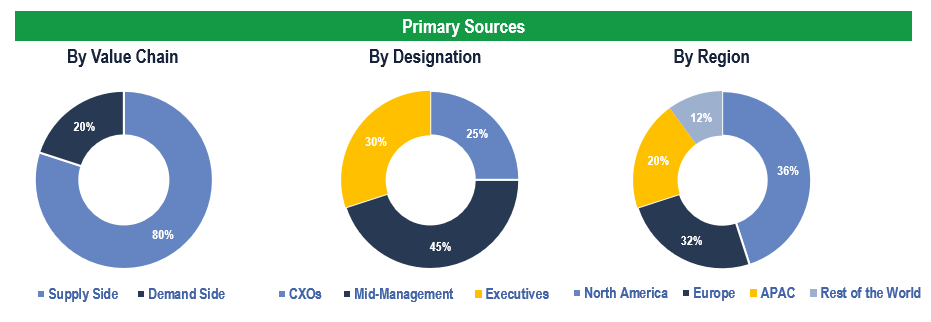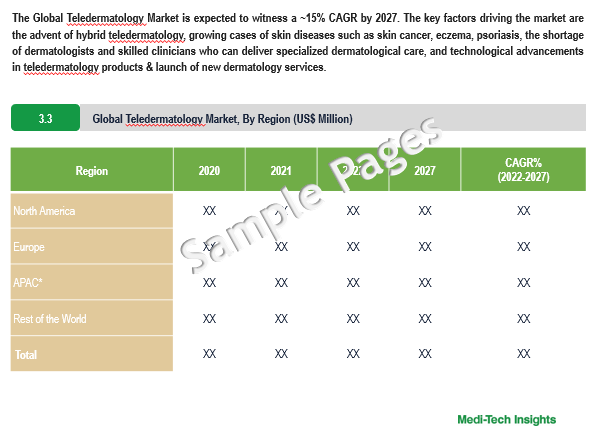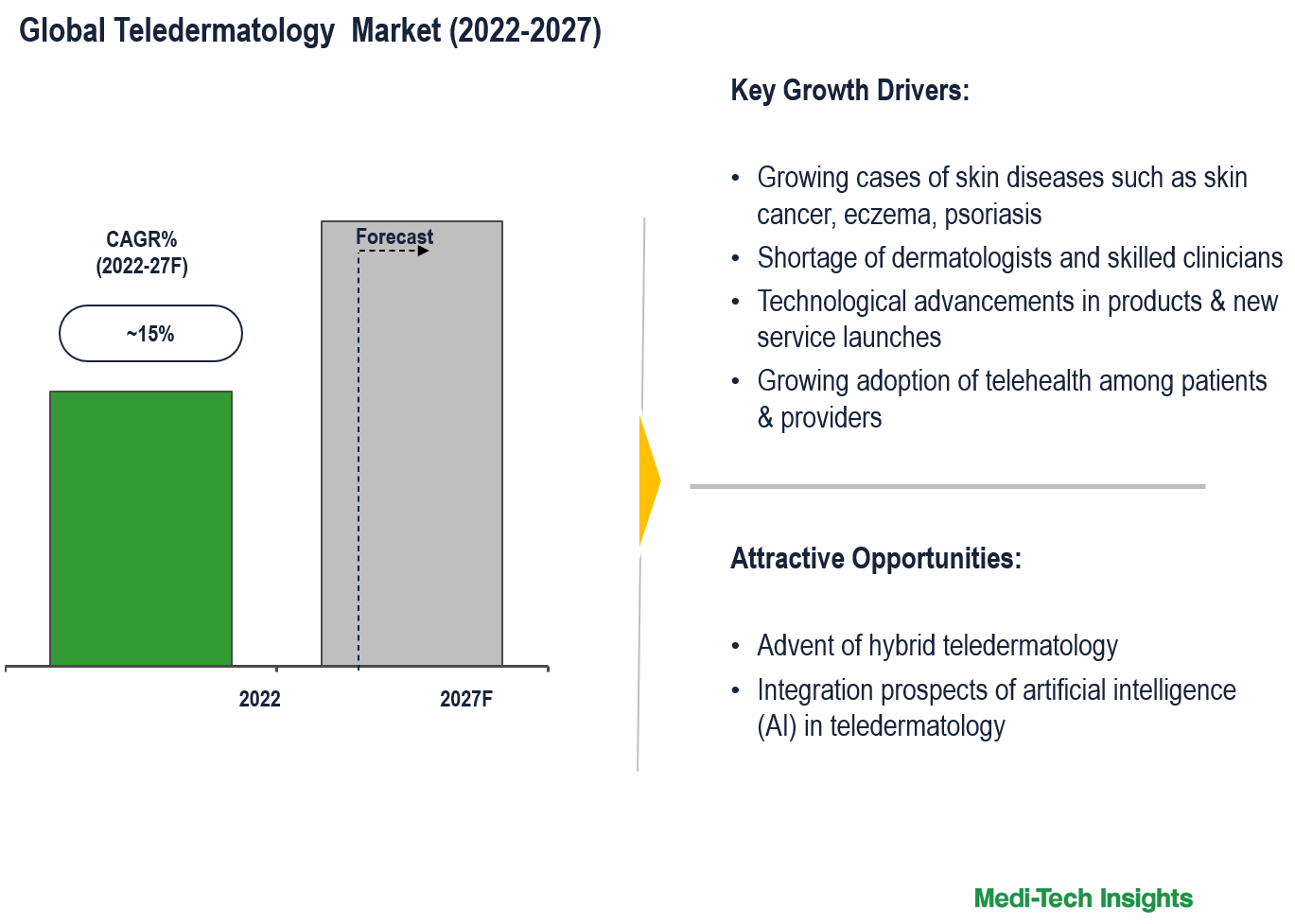
Teledermatology Market is Growing at a CAGR of ~15% from 2023 to 2027
The Global Teledermatology Market is expected to witness a ~15% CAGR by 2027. The key factors driving the market are the advent of hybrid teledermatology, growing cases of skin diseases such as skin cancer, eczema, psoriasis, the shortage of dermatologists and skilled clinicians who can deliver specialized dermatological care, and technological advancements in teledermatology products & launch of new dermatology services. To learn more about the research, fill out a quick inquiry for a sample report.
Teledermatology is an innovative and evolving model of care delivery where telecommunication technologies are used to exchange dermatology-related medical information over a distance using audio, visual, and data communication.
Asynchronous (Store-and-Forward) Segment Dominates the Teledermatology Market While Hybrid Teledermatology is Expected to Gain Momentum in the Coming Years
Store-and-forward (SAF) teledermatology allows the transmission of images and other health-related information from a patient to a provider/clinician or from a provider/clinician to another provider/clinician through telehealth software for review. Benefits such as reduced waiting times for consultations, fast-track treatment of urgent cases, efficient management of greater volume of patient cases, and enhanced patient satisfaction are some of the key factors that is driving its demand. However, the lack of real-time feedback on patient queries/concerns is a key factor that is expected to limit its adoption to a certain extent.
The advent of hybrid teledermatology is expected to gain momentum in the coming years. It combines elements of real-time and store-and-forward teledermatology. Through the hybrid approach, patients have the option to select the mode of consultation that resonates with them, patients can gain insights from real-time discussions and take advantage of the thoroughness of asynchronous data sharing. The approach reduces waiting time, improves access to care, and enhances patient satisfaction.
Technological Advancements and the Launch of New Services in Teledermatology Fuel the Market
The Teledermatology market has witnessed a number of technological advancements and the launch of new services over the years. These developments are expected to spur the teledermatology market in the coming years.
For instance:
- In May 2023, the Black Country Provider Collaborative launched new teledermatology services in the UK that aim to triage patients within a 24-hour period, reduce unnecessary appointments, and streamline access to diagnostics and treatments
- In Septemeber 2022, Oro Health in partnership with MCI Onehealth launched a new Teledermatology platform In Ontario for private and public patients. The new MCI platform, MCI Dermatology Connect, is powered by Oro Health Technology and provides a highly secured and reliable medical process. By using the platform, patients from the comfort of their homes will be able to receive personalized consultation, diagnosis, and prescription for minor dermatology pathologies within few days
Fill out the "Quick Inquiry Form" to request a sample copy
Competitive Landscape
Some of the key players operating in the market include MedX Health, Digital Diagnostic/3Derm Systems, MetaOptima, Miiskin, Hims & Hers, Mandel Dermatology, MDLIVE, Medweb, First Derm, Dermicus, Eagle Telemedicine, Advanced Telemed Services, SkyMD, Integrated Dermatology, Curology, among others.
Organic and Inorganic Growth Strategies Adopted by Players to Establish Their Foothold in the Market
Players operating in this market are adopting organic and inorganic growth strategies such as launching new products, launching pilot programs, acquiring related firms, and entering into collaborations to garner higher market share. For instance,
- In April 2023, MedX Health, a global leader in teledermatology entered into an agreement with PharmaChoice Canada to launch MedX teledermatology screening platform across canada. PharmaChoice Canada is one of Canada’s fastest-growing pharmacy groups, with more than 1000 independent pharmacy owners and operators
- In July 2021, Hims & Hers Health, acquired teledermatology specialist, Apostrophe. The acquisition expands the firm's ability to provide consumers with some of the most advanced and personalized dermatology treatments, faster and at scale
The Teledermatology Market is expected to gain further momentum in the coming years due to integration prospects of artificial intelligence (AI) in teledermatology for enhancing diagnosis accuracy, streamlining workflows, and optimizing patient care, the growing adoption of telehealth among patients & providers, and aggressive organic and inorganic growth strategies followed by the players.
Teledermatology Market Scope
|
Report Metric |
Details |
|
Market Growth Projection |
The Global Teledermatology Market is expected to witness a ~15% Compound Annual Growth Rate (CAGR) by the year 2027. |
|
Key Drivers |
|
|
Dominant Segment |
Asynchronous (Store-and-Forward) teledermatology segment currently dominates the market. |
|
Emerging Trend |
Hybrid Teledermatology is expected to gain momentum, combining real-time and store-and-forward approaches. This allows patients to choose consultation modes and benefits from both real-time discussions and asynchronous data sharing. |
|
Technological Advancements |
The market has witnessed continuous technological advancements, including the launch of new services, expected to fuel future growth. |
|
Competitive Landscape |
Key players include MedX Health, Digital Diagnostic/3Derm Systems, MetaOptima, Miiskin, Hims & Hers, Mandel Dermatology, MDLIVE, Medweb, First Derm, Dermicus, Eagle Telemedicine, Advanced Telemed Services, SkyMD, Integrated Dermatology, Curology, among others. |
|
Growth Strategies |
Players adopt organic and inorganic strategies such as launching new products, pilot programs, acquisitions, and collaborations. |
- Research Methodology
- Secondary Research
- Primary Research
- Market Estimation
- Market Forecasting
- Executive Summary
- Market Overview
- Market Dynamics
- Drivers
- Restraints
- Opportunities
- Industry Speaks
- Market Dynamics
- Teledermatology Market - Size & Forecast (2019-2027), By Offering
- Products
- Services
- Teledermatology Market - Size & Forecast (2019-2027), Type
- Synchronous (Live Video Conferencing)
- Asynchronous (Store-and-Forward)
- Hybrid Teledermatology
- Teledermatology Market - Size & Forecast (2019-2027), By Region
- North America (U.S. & Canada)
- Europe (UK, Germany, France, Italy, Spain, Rest of Europe)
- Asia Pacific (China, India, Japan, Rest of Asia Pacific)
- Rest of the World (Latin America, Middle East & Africa)
- Competitive Landscape
- Key Players and their Competitive Positioning
- Competitive Positioning of Key Players (2022)
- Product & Service Offerings Assessment, By Players
- Key Strategies Assessment, By Player (2021-2023)
- New Product & Service Launches
- Partnerships, Agreements, & Collaborations
- Mergers & Acquisitions
- Other Developments
- Key Players and their Competitive Positioning
- Key Companies Scanned (Indicative List)
- MedX Health
- Digital Diagnostic/3Derm Systems
- MetaOptima
- Miiskin
- Hims & Hers
- First Derm
- Mandel Dermatology
- MDLIVE
- Curology
- Medweb
- Dermicus
- Eagle Telemedicine
- Advanced Telemed Services
- SkyMD
- Integrated Dermatology
- Other Players
The study has been compiled based on extensive primary and secondary research.
Secondary Research (Indicative List)

Primary Research
To validate research findings (market size & forecasts, market segmentation, market dynamics, competitive landscape, key industry trends, etc.), extensive primary interviews were conducted with both supply and demand-side stakeholders.
Supply Side Stakeholders:
- Senior Management Level: CEOs, Presidents, Vice-Presidents, Directors, Chief Technology Officers, Chief Commercial Officers
- Mid-Management Level: Product Managers, Sales Managers, Brand Managers, Business Development Managers, Consultants
Demand Side Stakeholders

Breakdown of Primary Interviews
Market Size Estimation
Both ‘Top-Down and Bottom-Up Approaches’ were used to derive market size estimates and forecasts.
Data Triangulation
Research findings derived through secondary sources & and internal analysis were validated with Primary Interviews, Internal Knowledge Repository, and Company Sales Data.
Key Strategic Questions Addressed
- What is the market size and forecast for the Teledermatology Market?
- What are the historical, present, and forecasted market shares and growth rates of various segments and sub-segments of the Teledermatology Market?
- What are the major growth drivers, restraints/challenges impacting the market?
- What are the opportunities prevailing in the market?
- What is the investment landscape?
- Which region has the highest share in the market? Which region is expected to witness the highest growth rate in the next 5 years?
- Who are the major players operating in the market? What is the competitive positioning of key players?
- Who are the new players entering the market?
- What are the key strategies adopted by players?




